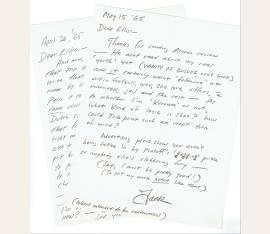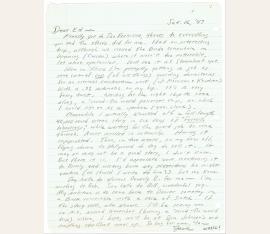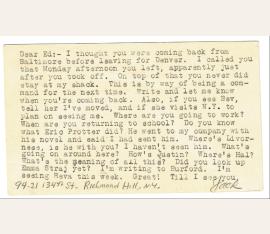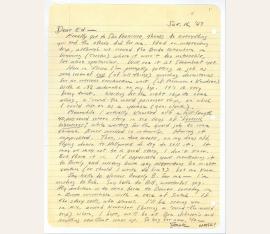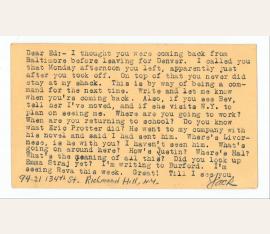American novelist and poet (1922-1969).
Rare correspondance with his editor Ellis Amburn consisting of 3 autograph letters signed and 3 typed letters signed. No place. 4to. 6 pp.
$ 30,016 / 28.000 €
(83297)
Rare correspondance with his editor Ellis Amburn: 11.2.1965 (typed letter signed „Jack Kerouac“): „[…] Krim’s introduction corrected as follows: […] Yours, Jack (Kerouac)“ 20.4.1965 (typed letter signed „Jack Kerouac“): „[…] The book looks superb and I want to thank you for the perfect transcription to print. The only stet I’ver found is on page 35, line 16, the word original is ‚originaal’ but that’s my fault. […] By the way, Ellis, be sure to mail the editor’s manuscript of ANGELS to agent Sterling Lord as soon as feasible: we’re donating it and other things to Morgan Library or someplace for tax deduction purposes.
With a good reprint sale I might need said deduction. Ok? […] I hope you werent put off by my objections in Krim intro. I just had to get all that straightened out. The intro will sell twice as many copies as it wouldhave sold, I can see now, among college students for instance. will give reviewers more meat that dustcover meat for lazy critiques. Now I want to go to London or someplace this summer and shadow around for new Duluoz keyhole views of world. Notwithstanding what they say about ‚Dulouz Legend,‘ as it goes on into future it will not be repetitious and eventually Dulouz will fade away like the narrator in Maugham’s marvelous series of stories. I write nothing I havent seen with my own eyes… (advice from Scott Fitz, who really didnt take his own advice with all that fictionalizing of what he saw.) (Just finisht Last Tycoon). Let me know about reprint sale, movie sale, world premiere an all the rest. (I’m not coming to New York for the simple reason I cant afford it). Got a postcard from Ginsberg in Moscow! Now who paid for that trip? Then he goes to Warsaw next week. […]“ 26.4.1965 (ALS with signature „Jack“): „[…] I want to take that trip to Europe at last and write that new book in a quiet room by candlelight - I’ll visit Paris a couple of times but my writing room will be in some German or Dutch city - So I would like that first installment of $3,999.60 right now, since my first royalty statement won’t be till 1966 - This is to put back what I took out of savings to pay 1964 taxes, for the trip to Europe, and to leave money in checking at home with my Mum - en route, I’ll see you in N.Y. - Soon as you can send the money, I’m off - Can the money be sent now? - Let me know“ 15.5.1965 (ALS with signature „Jack“): „[…] Thanks for sending Algren review - He aint read about my real ‚youth‘ yet (VANITY OF DULOUZ next book) and it certainly wasnt ‚defensive‘ at all: - football, war, 300 love affairs, 2 marriages, jail and the rest - As to whether I’m ‚Kerouac‘ or not, what kind of logic is that? how could Trib print such an inept turn of mind? Advertising plans show you aren’t being taken in by Maloff’s ‚gagging’ puke or anybody else’s slobbering fury - (Say, I must be pretty good!) (To get my work hated like that) Jack (wasnt intended to be controversial)“ 29.7.1967 (ALS with signature „Jack“): „[…] Negatives following - making copies for ourselves - The bill will follow from Parkway Photo, Lowell - Hope thes O.K. - As ever Jack“ 13.9.1967 (typed letter with signature „Jack“ and ALS addition signed „JK“): „[…] Finally I had included a photo of me taken last November 1966, profile, laughing in chair, did you get that? I want that one for the cover. Unless you insist on a completely recent photo, that is, a photo taken next December 1967 when I shall probably in Sheol. […] Always glad to hear from you, Ellis, and still hope to SEE [funny little sketch of a laughing face added] you someday. […] Anyway, remember that the smiling photo of me in the chair, that I want for my cover, was my more-or-less wedding photo, and I would like that , i havent changed, as you’ll see when I bust in on you with my Boston Costa Nostra gang and raid your office of erasers. […] Astronomical charges yoursel - do you want perfection in literature or dont ya? - (No more than 180 changes, this includes the printers’ goofs.)“ Jean-Louis Lebris de Kérouac, better known as Jack Kerouac, was - alongside William S. Burroughs and Allen Ginsberg - a pioneer of the Beat Generation. The conversation between him and his editor Ellis Amburn (1933-2018) is revolving around „Vanity of Duluoz“ (written in 1967, published 1968) and „Desolation Angels“ (written by 1961 and published 1965). „Vanity of Duluoz: An Adventurous Education“ is a semi-autobiographical novel, describing the adventures of Kerouac's alter ego, Jack Duluoz, covering the period of his life between 1935 and 1946. It culminates with the beginnings of the beat movement. It was the last work published a year before Kerouac's death in 1969. „Desolation Angels“ also is a semi-autobiographical novel, which makes up part of his Duluoz Legend. According to the book's foreword, the opening section of the novel is taken almost directly from the journal he kept when he was a fire lookout on Desolation Peak. The correspondence between Kerouac and his editor gives an insight into the author’s precision but also in financial matters and his aim to gain sales and to reduce tax bills..
American novelist and poet (1922-1969).
Autograph letter signed (“Jack”) to Ed White. postmarked Sausalito, California. Quarto. Single leaf of ruled paper; recto only; creased; pencil, with “WRITE!” added in ink as an afterthought following signature. With envelope addressed in autograph.
$ 16,080 / 15.000 €
(91252)
Unpublished autograph letter signed (“Jack”) to Ed White: "My ambition is to come back to Denver someday in a Buick convertible with a case of Scotch.” The first full letter from Kerouac to White, sent from Sausalito, just across the Golden Gate Bridge from San Francisco. At the end of the three-week Denver stay memorialized in On the Road, Jack continued his first cross-country hitchhiking venture, heading over the Rocky Mountains to California. White and his brother Frank drove him, dressed in his lumberjack shirt and cap, carrying a canvas suitcase, to a highway west of town.
White's mother, who had adopted an immediate motherly attraction to Jack, provided him with a travel lunch in a brown paper bag. Though White briefed him on the beautiful passes and scenic sites he should see while crossing the Rocky Mountains, notably Rabbit Ears Pass, which was, in the summer of 1947, a spectacular drive, Kerouac of course ended up going where his truck driver took him, which proved to be a different route. He reports, “Here in ’Frisco I’m promptly getting a job as some sort of cop (of all things) guarding dormitories for an overseas construction unit [...] with a .32 automatic on my hip. It’s a very funny twist.” And although it never happened, Jack was at that moment in his fantasy, “waiting for the right ship to come along, a ’round-the-world passenger ship.” In what would prove to be typical, he announces his most recent creative accomplishment: Meanwhile I actually knocked off a full-length 40,000 word screen story in six days of “feverish labourings,” while waiting for the guard job to come through. Never worked so intensely. Having it copyrighted. Then, in two weeks, on my days off, flying down to Hollywood to try to sell it. It may or may not be a good story, I don’t know. But there it is. I’d appreciate your mentioning it to [Justin] Brierly and writing back any suggestions he might venture. [...] Let me know. He concludes the letter with an often-repeated intention to return to Denver, but more realistically adds, “I’ll be seeing you in N.Y. around November”—and it was there that he and Ed were to see much more of each other..
American novelist and poet (1922-1969).
Typed postcard signed (“Jack”) to Ed White. postmarked October 10, 1949, Jamaica, New York. Oblong-small-8vo. 1 p. With autograph postscript providing his new address.
$ 4,074 / 3.800 €
(91253)
To Ed White: A postcard marking Kerouac's new address in Queens, 94-21 134th Street, Richmond Hill. Here he scolds White for not visiting during a trip to New York: “You never stay at my shack.” He also asks White to let Bev Burford know he’d moved. Bev also hailed from Denver and had been White's girlfriend for a time. She would be involved with Kerouac briefly in the spring of 1950 and would serve as the model for the character Babe Rawlins in On the Road. He intersperses his news with queries: “How’s Justin? Where’s Hal?” White and Kerouac were once again separated by two thousand miles and their correspondence would resume.
American novelist and poet (1922-1969). Autograph letter signed (“Jack”). Marin City, CA. 4to (216 x 281 mm). 1 p. In pencil on ruled paper. With autograph envelope.
$ 16,080 / 15.000 €
(91505/BN60744)
The first full letter to his friend Edward D. White Jr. in Denver, informing him of his arrival in San Francisco, a new job as a guard, further plans and the conclusion of a "40,000-word screen story", very likely "Christmas in New York". In the summer of 1947, Kerouac spent three weeks with White, to whom he had been introduced by Hal Chase in New York in 1946, and his family in Denver, before continuing his first cross-country hitchhiking venture memorialized in "On the Road". At the end of his stay, White and his brother Frank drove Kerouac to a highway west of town, while their mother had provided him with a travel lunch.
Though White briefed him on the beautiful passes and scenic sites he should see while crossing the Rocky Mountains, notably Rabbit Ears Pass, Kerouac of course ended up going where his truck driver took him, which proved to be a different route. - The letter in full: "Finally got to San Francisco, thanks to everything you and the others did for me. Had an interesting trip, although we crossed the divide somewhere in Wyoming (Creston) where it wasn't too noticeable, let alone spectacular. Will see it at Steamboat yet. Here in Frisco I'm promptly getting a job as some sort of cop (of all things) guarding dormitories for an overseas construction unit (of Morrisson & Knudsen.) With a .32 automatic on my hip. It's a very funny twist, waiting for the right ship to come along, a 'round-the-world passenger ship, on which I could sign on as a yeoman (gen. clerk.). Meanwhile I actually knocked off a full-length 40,000-word screen story in six days of 'feverish labourings', while waiting for the guard job to come through. Never worked so intensely. Having it copyrighted. Then, in two weeks, on my days off, flying down to Hollywood to try to sell it. It may or may not be a good story, I don't know. But there it is. I'd appreciate your mentioning it to Brierly and writing back any suggestions he might venture (or should I write to him?) Let me know. Say hello to glorious Beverly B. for me - I'm writing to Bob. Say hello to Bill, wonderful guy. My ambition is to come back to Denver someday in a Buick convertible with a case of scotch. If the story sells, who knows. I'll be seeing you in N.Y. around November (barring a 'round-the-world trip) where, I hope, we'll be at Ben Johnson's and anything new that comes up. So long for now." Added in ink: "WRITE!". - Neither the "round-the-world trip" on a passenger ship nor the sale of his screenplay in Hollywood ever materialized. Kerouac returned to New York in early October 1947, where he reunited with White, anxiously waiting for the studios to respond. In late November, he took "Christmas in New York" to the literary agency Bergh & Winner but, again, nothing became of it. Today, the 99 page-strong autograph manuscript is in the collection of the New York Public Library (b. 10 f. 3). - The later teacher and lawyer Justin W. Brierly (1905-85), who is mentioned in the letter, is best known today for discovering and supporting the young Neal Cassady. The "glorious" Beverly Burford briefly dated Edward D. White Jr. and would be involved with Jack Kerouac in the spring of 1950. She served as the model for the character Babe Rawlins in "On the Road". Her older brother Bob Burford (1924-2004) was an editor of the New Story magazine together with Robert Lax. Kerouac's lifelong friend Edward D. White Jr. inspired characters such as Tim Gray (On the Road), Ed Gray (Visions of Cody), and Al Green (Book of Cody). - Traces of folds and minimal tears to the margins..
American novelist and poet (1922-1969). Typed postcard with autograph postscript signed ("Jack"). Jamaica, New York. Oblong 12mo (140 x 83 mm). 1 p. and 1 autograph line in pencil.
$ 4,074 / 3.800 €
(91506/BN60745)
Informing his friend Edward D. White Jr. of his new address in Queens, 94-21 134th Street, Richmond Hill, and scolding him for not visiting during a trip to New York: "I thought you were coming back from Baltimore before leaving for Denver. I called you that Monday afternoon you left, apparently just after you took off. On top of that you never did stay at my shack. This is by way of being a command for the next time". Kerouac asks White to give his new address to their mutual friend Beverly Burford, relates a story about the author and art critic Eric Protter going to Kerouac's publisher Harcourt Brace "with his novel", claiming that Kerouac "had sent him", and adds multiple queries: "Where are you going to work? When are you returning to school? Do you know what Eric Protter did? He went to my company with his novel and said I had sent him.
Where's Livornese, is he with you? I haven't seen him. What's going on around here? How's Justin? Where's Hal? What's the meaning of all this? Did you look up Emma Straj yet? I'm writing to Burford. I'm seeing Reva this week. Great! Till I see you". - Justin and Hal can be identified with some certainty as the archaeologist Haldon Chase (1923-2006) and the teacher and lawyer Justin W. Brierly (1905-85), who is best known for discovering and supporting the young Neal Cassady. Tom Livornese was a lawyer and amateur jazz musician who had introduced Kerouac and White to the New York jazz scene. Burford was Beverly's older brother Bob (1924-2004) who, together with Eric Protter and Robert Lax, was an editor of the New Story magazine. His sister Beverly had briefly dated Edward D. White Jr. and would be involved with Jack Kerouac in the spring of 1950. She served as the model for the character Babe Rawlins in "On the Road", while his lifelong friend White inspired characters such as Tim Gray (On the Road), Ed Gray (Visions of Cody), and Al Green (Book of Cody). - 1949 was an important year for Jack Kerouac as he finally found a publisher for "The Town and the City" and even received an advance while already working on "On the Road". In August 1949, Kerouac and his beloved mother moved from their famous apartment in Ozone Park to a nearby house in Richmond Hill. When in New York, Kerouac would stay at the house, where he had many important guests and wrote "Maggie Cassidy" and "The Subterraneans" (both in 1953), until the family gave it up in 1955. - Autograph postscript marking the new address..

